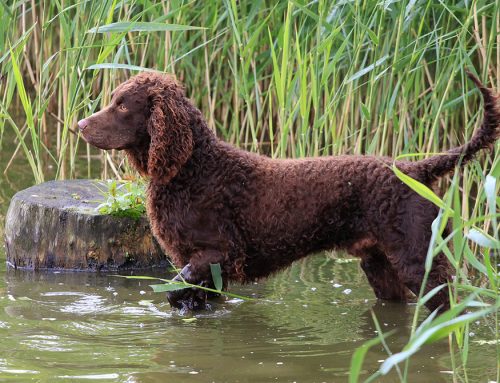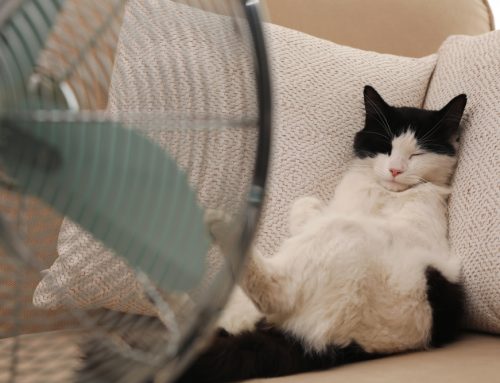IT IS NATIONAL PET ID WEEK, EVERYONE!
Did you know that 1 in 3 pets will go missing over their lifetime? Without ID, 90% of pets do not come home. So, what are some ways to help identify your pet, if they go missing? This blog will give us an opportunity to think about what we can do if the unthinkable happens, and our pets go missing.
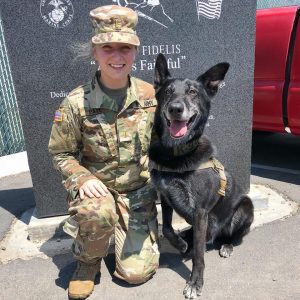 Much like our own, Galina Pate (future military veterinarian and spring intern) knows, dog tags are a required form of identification in the military. If the soldiers, canine or human, are without these ID tags, they may not be identified if they are hurt or go missing in combat. This same thought process of ID tags is applicable to dogs and cats, as a necessity be worn at all times.
Much like our own, Galina Pate (future military veterinarian and spring intern) knows, dog tags are a required form of identification in the military. If the soldiers, canine or human, are without these ID tags, they may not be identified if they are hurt or go missing in combat. This same thought process of ID tags is applicable to dogs and cats, as a necessity be worn at all times.
Take a look at what you have chosen for your pet’s outward ID. Is your phone number present? How about your name and address? Are they legible? Has their collar become damaged or their tags scratched? Does your pet even wear a collar? Have you moved recently? Is the contact information up-to-date on the tag or collar?
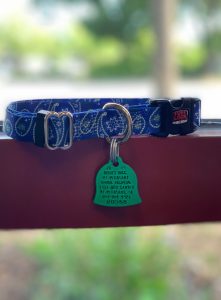 Rabies tags from animal hospitals are helpful too, but in the event the pet goes missing over a holiday or weekend, the reuniting may be delayed. (Please note that not all veterinary clinics provide their telephone number or address on the tags.) Traveling with your pet is also a potential risk for when they may become separated from you. A collar is a universal symbol for ownership. Just by placing a collar on your pet, it tells others that your pet has a family, and if the pet is missing, that someone, somewhere is looking for them. That being said, collars and tags are not the end-all be-all, of pet IDs. There are definitely some potential short comings of using collars and tags as your pet’s only mode of identification.
Rabies tags from animal hospitals are helpful too, but in the event the pet goes missing over a holiday or weekend, the reuniting may be delayed. (Please note that not all veterinary clinics provide their telephone number or address on the tags.) Traveling with your pet is also a potential risk for when they may become separated from you. A collar is a universal symbol for ownership. Just by placing a collar on your pet, it tells others that your pet has a family, and if the pet is missing, that someone, somewhere is looking for them. That being said, collars and tags are not the end-all be-all, of pet IDs. There are definitely some potential short comings of using collars and tags as your pet’s only mode of identification.

Collars and tags are not permanent. So, what are your options in the event that the collar or tag is no longer attached to your pet? Microchips! We realize an additional form of identification is necessary and microchipping is a wonderful and permanent way of providing lifetime identification for your fur baby! This is a non-painful procedure that can be done in an awake pet much like a shot. The tiny chip is implanted between the shoulder blades, holding an ID number that is unique to your pet. This ID number, when scanned with a universal scanner, reveals itself.
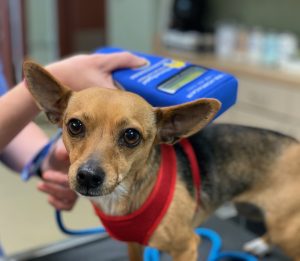 Please note that you must register your pet with Home Again, or alternative microchip manufacturer, because a microchip is only as good as the information it holds. People move, drop their land line, or simply forget to update their information. If this information is kept current, and your pet happens to go missing, the likelihood of your pet being return to you dramatically increases. Home Again microchips reunite approximately 14,000 pets with their families, MONTHLY!
Please note that you must register your pet with Home Again, or alternative microchip manufacturer, because a microchip is only as good as the information it holds. People move, drop their land line, or simply forget to update their information. If this information is kept current, and your pet happens to go missing, the likelihood of your pet being return to you dramatically increases. Home Again microchips reunite approximately 14,000 pets with their families, MONTHLY!
So this week, take a moment to evaluate your pet ID strategy. Our doctors recommend using a combination of tags, collars, and chips for your pets. No tag? No collar? No chip? NO PROBLEM! Come see us, and we can get you and your fur family chipped and tagged today!


